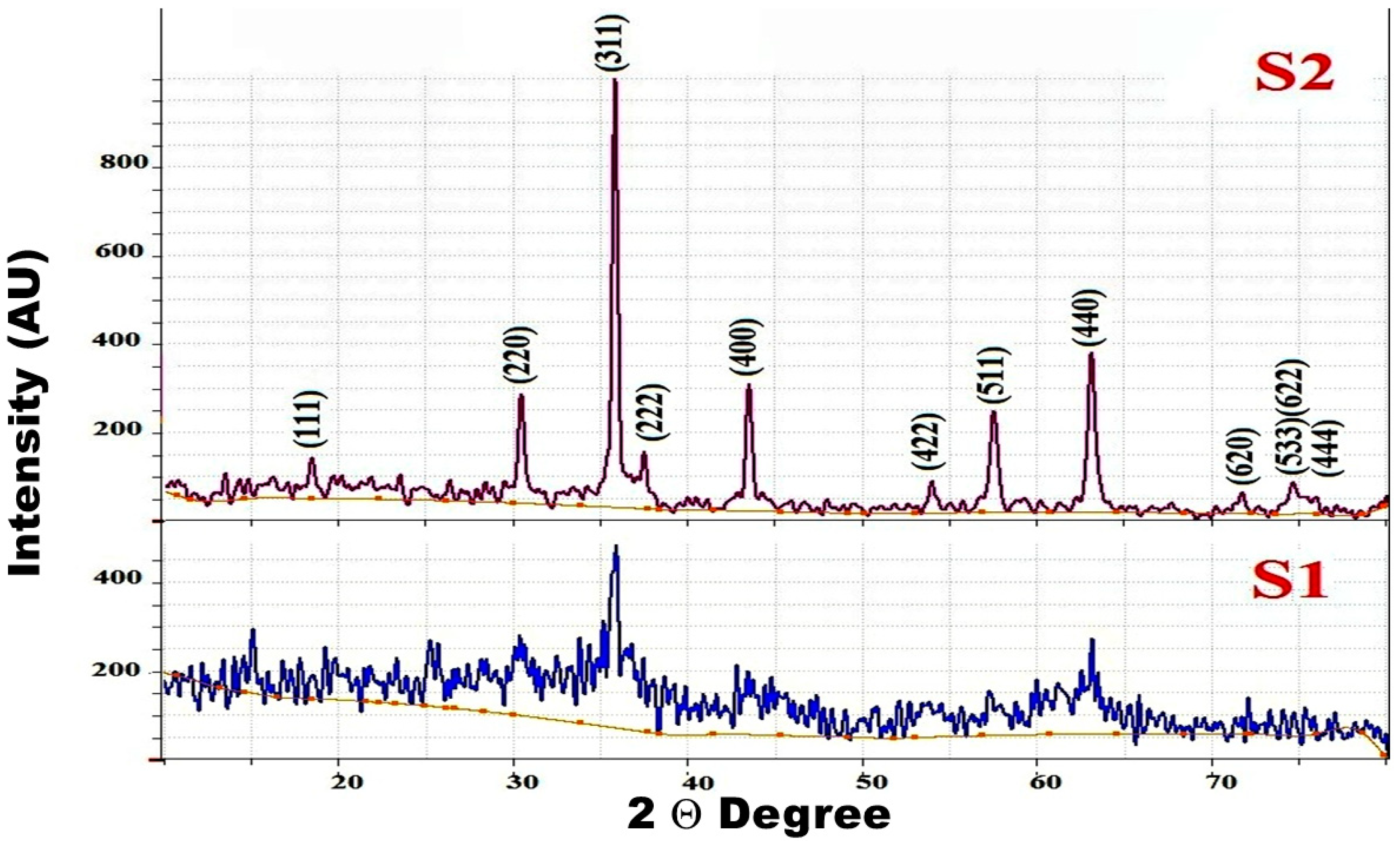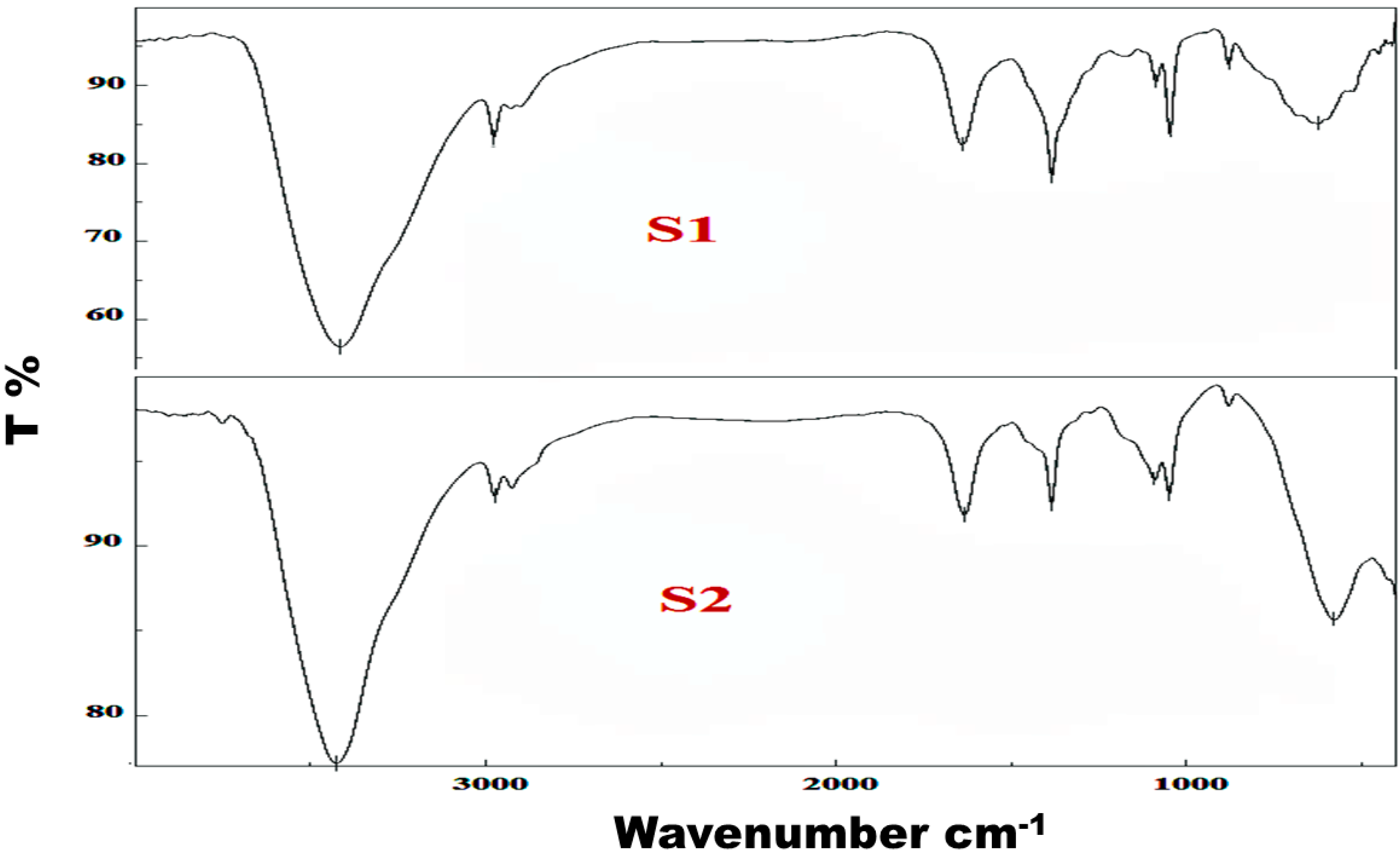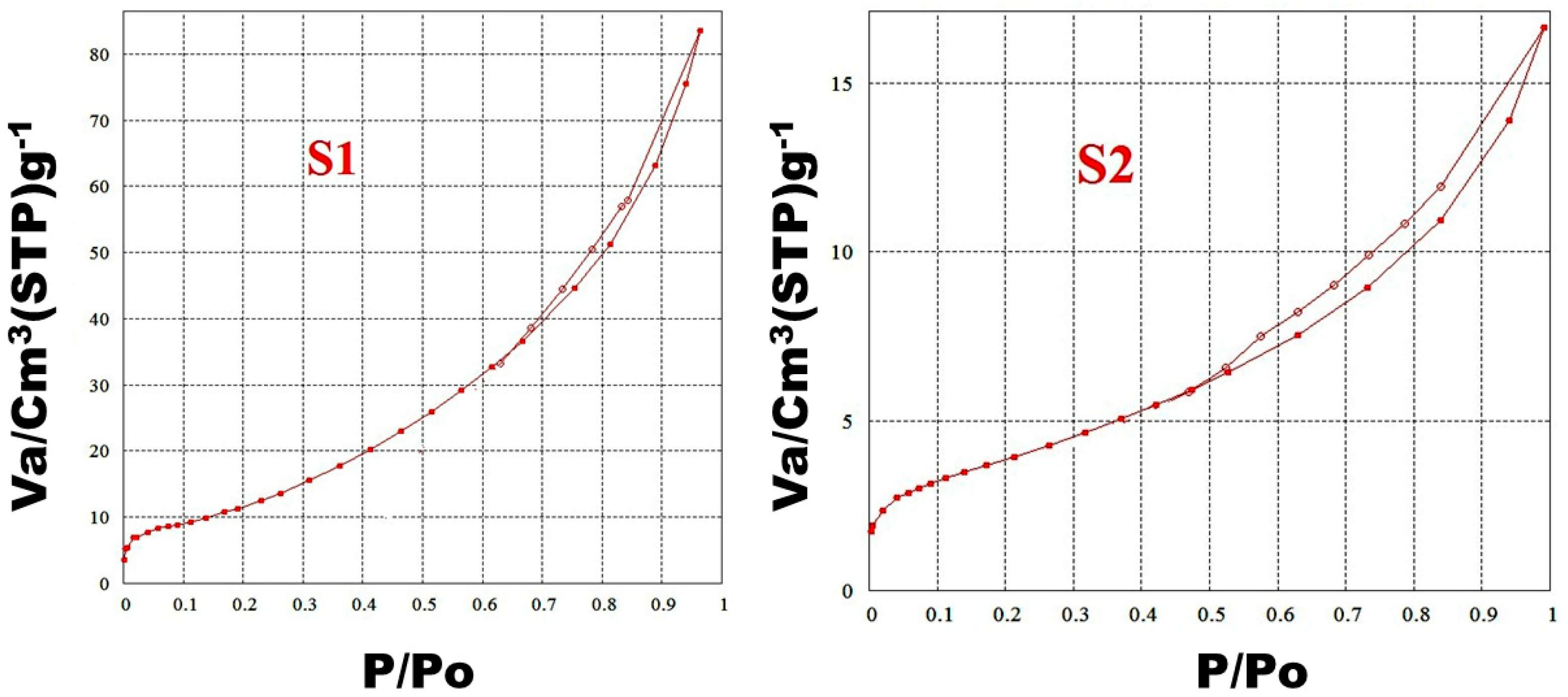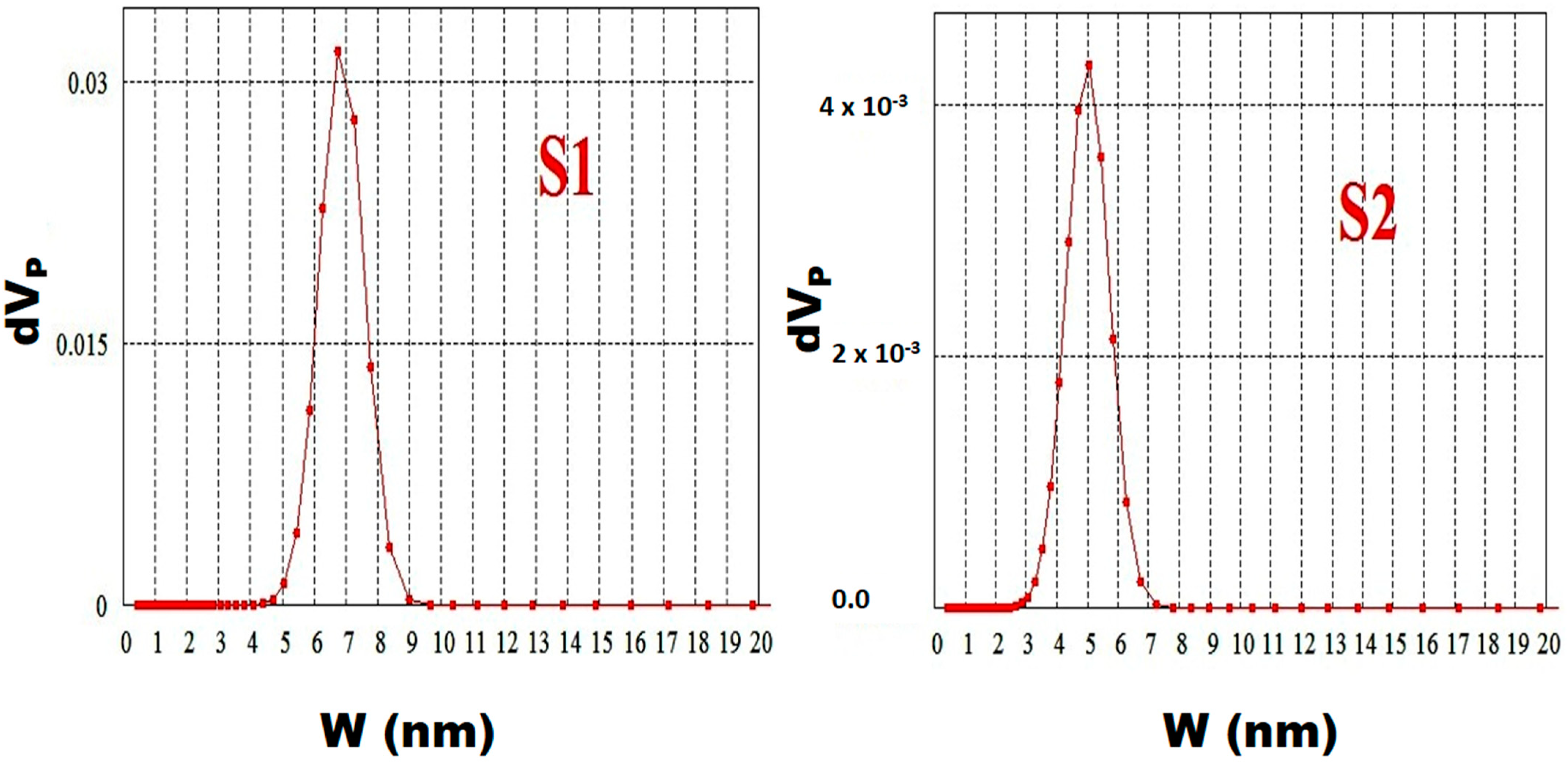Biosynthesis, Physicochemical and Magnetic Properties of Inverse Spinel Nickel Ferrite System
Abstract
1. Introduction
2. Materials and Methods
2.1. Materials
2.2. Preparation Route
2.3. Characterization Techniques
3. Results
3.1. XRD Measurements
3.2. FTIR Analysis
3.3. TEM Morphological Study
3.4. Surface Characteristics
3.5. Magnetic Properties
4. Discussion
5. Conclusions
Author Contributions
Funding
Institutional Review Board Statement
Informed Consent Statement
Data Availability Statement
Acknowledgments
Conflicts of Interest
References
- Deraz, N.M. The heat treatment based soft technology for synthesis of hopcalite/hausmannite nanocomposite. J. Ind. Environ. Chem. 2018, 2, 4–6. [Google Scholar]
- Deraz, N.M. Mechanism of oxide spinel’s formation. Sci. Fed. J. Quantum Phys. 2018, 2, 1000001. [Google Scholar]
- Alarifi, A.; Deraz, N.M.; Shaban, S. Structural, morphological and magnetic properties of NiFe2O4 nanoparticles. J. Alloys Compd. 2009, 486, 501–506. [Google Scholar] [CrossRef]
- Valenzuela, R. Novel Applications of Ferrites. Phys. Res. Int. 2012, 2012, 591839. [Google Scholar] [CrossRef]
- Deraz, N.M.; El-Aiashy, M.K.; Ali, S.A. Novel preparation, magneto-chemical characterization and catalytic behavior of nanocrystalline cobalt ferrite catalysts. Adsorp. Sci. Technol. 2009, 27, 803–816. [Google Scholar] [CrossRef]
- Kumar, E.R.; Reddy, P.S.P.; Devi, G.S.; Sathiyaraj, S. Structural, dielectric and gas sensing behavior of Mn substituted spinel MFe2O4 (M = Zn, Cu, Ni, and Co) ferrite nanoparticles. J. Magn. Magn. Mater. 2016, 398, 281–288. [Google Scholar] [CrossRef]
- Shan, A.; Wu, X.; Lu, J.; Chen, C.; Wang, R. Phase formations and magnetic properties of single crystal nickel ferrite (NiFe2O4) with different morphologies. Cryst. Eng. Comm. 2015, 17, 1603–1608. [Google Scholar] [CrossRef]
- Jaffari, G.H.; Rumaiz, A.K.; Woicik, J.C.; Shah, S.I. Influence of oxygen vacancies on the electronic structure and magnetic properties of NiFe2O4 thin films. J. Appl. Phys. 2012, 111, 093906. [Google Scholar] [CrossRef]
- Galvao, W.S.; Neto, D.M.A.; Freire, R.M.; Fechine, R.B.A. Super-paramagnetic nanoparticles with spinel structure: A review of synthesis and biomedical applications. Solid State Phenom. 2016, 241, 139–176. [Google Scholar] [CrossRef]
- Piao, X.; Zeng, G.M.; Huang, D.L.; Feng, C.L.; Hu, S.; Zhao, M.H.; Lai, C.; Wei, Z.; Huang, G.; Xie, G.X.; et al. Use of iron oxide nanomaterials in wastewater treatment: A review. Sci. Total Environ. 2012, 424, 1–10. [Google Scholar]
- Reddy, D.H.K.; Yun, Y.S. Spinel ferrite magnetic adsorbents: Alternative future materials for water purification. Coord. Chem. Rev. 2016, 315, 90–111. [Google Scholar] [CrossRef]
- Hua, M.; Zhang, S.; Pan, B.; Zhang, W.; Zhang, L.L.Q. Heavy metal removal from water/wastewater by nanosized metal oxides: A review. J. Hazard. Mater. 2012, 211–212, 317–331. [Google Scholar] [CrossRef] [PubMed]
- Deraz, N.M.; Shaban, S.A.; Alarifi, A. Removal of sulfur from commercial kerosene using nanocrystalline NiFe2O4 based sorbents. J. Saudi Chem. Soc. 2010, 14, 357–362. [Google Scholar] [CrossRef]
- Deraz, N.M. Effects of magnesia addition on structural, morphological and magnetic properties of nanocrystalline nickel ferrite system. Ceram. Int. 2012, 38, 511–516. [Google Scholar] [CrossRef]
- Deraz, N.M.; Abd-Elkader, O.H. Production and Characterization of Nano-Magnetic Ni0.5Zn0.5Fe2O4 Spinel Solid Solution. J. Anal. Appl. Pyrolysis 2014, 106, 171–176. [Google Scholar] [CrossRef]
- Deraz, N.M.; Abd-Elkader, O.H. Processing and Characterization of Nano-Magnetic Co0.5Ni0.5Fe2O4 System. J. Ind. Eng. Chem. 2014, 20, 3251–3255. [Google Scholar] [CrossRef]
- Deraz, N.M. Cation distribution: From here the beginning. Sci. Fed. Mater. Res. Lett. 2019, 3, 1000001. [Google Scholar]
- Mohsen, Q.; Abd Elkader, O.H.; Farouk, A.; Hassan, H.M.A.; Mostafa, N.Y. Influence of tungsten substitution on structure, optical, vibrational and magnetic properties of hydrothermally prepared NiFe2O4. Appl. Phys. A 2021, 127, 296. [Google Scholar] [CrossRef]
- Prasad, S.; Gajbhiye, N.S. Magnetic studies of nanosized nickel ferrite particles synthesized by citrate precursor technique. J. Alloys Compd. 1998, 265, 87–92. [Google Scholar] [CrossRef]
- Chen, D.H.; He, X.R. Synthesis of nickel ferrite nanoparticles by sol–gel method. Mater. Res. Bull. 2001, 36, 1369–1377. [Google Scholar] [CrossRef]
- Abbas, M.K.; Khan, M.A.; Mushtaq, F.; Warsi, M.F.; Sher, M.; Shakir, I.; Aly Aboud, M.F. Impact of Dy on structural, dielectric and magnetic properties of Li-Tb-nanoferrites synthesized by micro-emulsion method. Ceram. Int. 2017, 43, 5524–5533. [Google Scholar] [CrossRef]
- Deraz, N.M. Facile and eco-friendly route for green synthesis of magnesium ferrite nano particles. Sci. Sinter. 2010, 52, 53–65. [Google Scholar] [CrossRef]
- Al Angari, Y.M. Magnetic properties of La-substituted NiFe2O4 via egg-white precursor route. J. Magn. Magn. Mater. 2011, 323, 1835–1839. [Google Scholar] [CrossRef]
- Wang, L.; Li, Z.; Liang, Y.; Zhao, K. Synthesis of Ni0.6Cu0.4Fe2O4 ferrite fine powder using egg white method. Appl. Mech. Mater. 2014, 492, 253–257. [Google Scholar] [CrossRef]
- Maensiri, S.; Masingboon, C.; Boonchomb, B.; Seraphin, S. A simple route to synthesize nickel ferrite (NiFe2O4) nanoparticles using egg white. Scr. Mater. 2007, 56, 797–800. [Google Scholar] [CrossRef]
- Abd-Elkader, O.; Al-Enizi, A.M.; Shaikh, S.F.; Ubaidullah, M.; Abdelkader, M.O.; Mostafa, N.Y. The Structure, Magnetic, and Gas Sensing Characteristics of W-Substituted Co-Ferrite Nanoparticles. Crystals 2022, 12, 393. [Google Scholar] [CrossRef]
- Rehwoldt, M.C.; Wang, Y.; Xu, F.; Ghildiyal, P.; Zachariah, M.R. High-Temperature Interactions of Metal Oxides and a PVDF Binder. ACS Appl. Mater. Interfaces 2022, 14, 8938–8946. [Google Scholar] [CrossRef]
- Al-Senani, G.M.; Al-Saeedi, S.I.; Al-Kadhi, N.S.; Abd-Elkader, O.H.; Deraz, N.M. Green Synthesis and Pinning Behavior of Fe-Doped CuO/Cu2O/Cu4O3 Nanocomposites. Processes 2022, 10, 729. [Google Scholar] [CrossRef]
- Vazquez-Olmos, A.R.; Abatal, M.; Sato-Berru, R.Y.; Pedraza-Basulto, G.K.; Garcia-Vazquez, V.; Sainz-Vidal, A.; Perez-Bañuelos, R.; Quiroz, A. Mechanosynthesis of MFe2O4 (M = Co, Ni, and Zn) Magnetic Nano-particles for Pb Removal from Aqueous Solution. J. Nanomater. 2016, 2016, 9182024. [Google Scholar] [CrossRef]
- Prasad, B.V.; Ramesh, K.V.; Srinivas, A. Structural and magnetic properties of nanocrystalline nickel ferrite (NiFe2O4) synthesized in sol-gel and combustion routes. Solid State Sci. 2018, 86, 86–97. [Google Scholar] [CrossRef]
- Narang, S.B.; Pubby, K. Nickel spinel ferrites: A review. J. Magn. Magn. Mater. 2021, 519, 167163. [Google Scholar] [CrossRef]
- Wahba, A.M.; Mohamed, M.B. Structural and magnetic characterization and cation distribution of nanocrystallineCoxFe3-xO4 ferrites. J. Magn. Magn. Mater. 2015, 378, 246–252. [Google Scholar] [CrossRef]
- Sedrati, C.; Alleg, S.; Boussafel, H.; Hacine, A.B. Structure and magnetic properties of nickel ferrites synthesized by a facile co-precipitation method: Effect of the Fe/Ni ratio. J. Mater. Sci. Mater. Electron. 2021, 32, 24548–24559. [Google Scholar]






| Parameters | S1 | S2 |
|---|---|---|
| d, nm | 4 | 18 |
| a, nm | 0.8284 | 0.8322 |
| V, nm3 | 0.5685 | 0.5764 |
| Dx, g/cm3 | 5.4769 | 5.4019 |
| LA, nm | 0.3587 | 0.3603 |
| LB, nm | 0.2928 | 0.2941 |
| A-O, nm | 0.1894 | 0.1902 |
| B-O, nm | 0.2137 | 0.2147 |
| rA, nm | 0.0574 | 0.0582 |
| rB, nm | 0.0817 | 0.0827 |
| I220/I440 | 1.878 | 7.645 |
| δ, Lines/nm2 | 0.0625 | 0.0031 |
| Samples | SBET (m2/g) | Vm (nm) | ȓ (nm) | Vp (cm3/g) | C-Constant |
|---|---|---|---|---|---|
| S1 | 57.258 | 13.183 | 9.0176 | 0.1165 | 13.247 |
| S2 | 13.934 | 3.202 | 7.3398 | 0.0216 | 114.260 |
| Sample | Ms (emu/g) | μi | μm | Hc (G) | Mr/Ms (emu/g) | Mr (emu/g) | Anisotropy Constant (Ka) |
|---|---|---|---|---|---|---|---|
| S1 | 6.6589 | 0.1640 | 0.1527 | 159.15 | 0.1526 | 1.0165 | 1081.39 |
| S2 | 37.727 | 5.8511 | 1.5834 | 113.74 | 0.1824 | 6.8801 | 4378.64 |
Publisher’s Note: MDPI stays neutral with regard to jurisdictional claims in published maps and institutional affiliations. |
© 2022 by the authors. Licensee MDPI, Basel, Switzerland. This article is an open access article distributed under the terms and conditions of the Creative Commons Attribution (CC BY) license (https://creativecommons.org/licenses/by/4.0/).
Share and Cite
Al-Senani, G.M.; Al-Fawzan, F.F.; Almufarij, R.S.; Abd-Elkader, O.H.; Deraz, N.M. Biosynthesis, Physicochemical and Magnetic Properties of Inverse Spinel Nickel Ferrite System. Crystals 2022, 12, 1542. https://doi.org/10.3390/cryst12111542
Al-Senani GM, Al-Fawzan FF, Almufarij RS, Abd-Elkader OH, Deraz NM. Biosynthesis, Physicochemical and Magnetic Properties of Inverse Spinel Nickel Ferrite System. Crystals. 2022; 12(11):1542. https://doi.org/10.3390/cryst12111542
Chicago/Turabian StyleAl-Senani, Ghadah M., Foziah F. Al-Fawzan, Rasmiah S. Almufarij, Omar H. Abd-Elkader, and Nasrallah M. Deraz. 2022. "Biosynthesis, Physicochemical and Magnetic Properties of Inverse Spinel Nickel Ferrite System" Crystals 12, no. 11: 1542. https://doi.org/10.3390/cryst12111542
APA StyleAl-Senani, G. M., Al-Fawzan, F. F., Almufarij, R. S., Abd-Elkader, O. H., & Deraz, N. M. (2022). Biosynthesis, Physicochemical and Magnetic Properties of Inverse Spinel Nickel Ferrite System. Crystals, 12(11), 1542. https://doi.org/10.3390/cryst12111542








